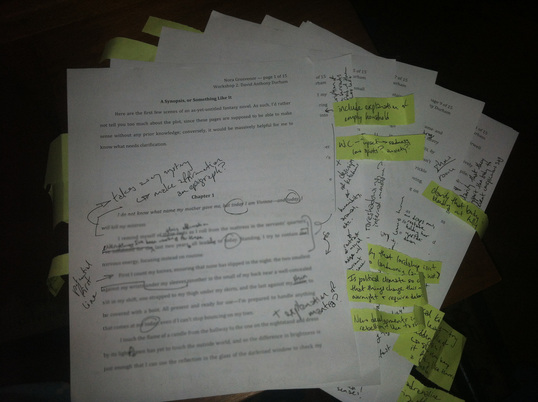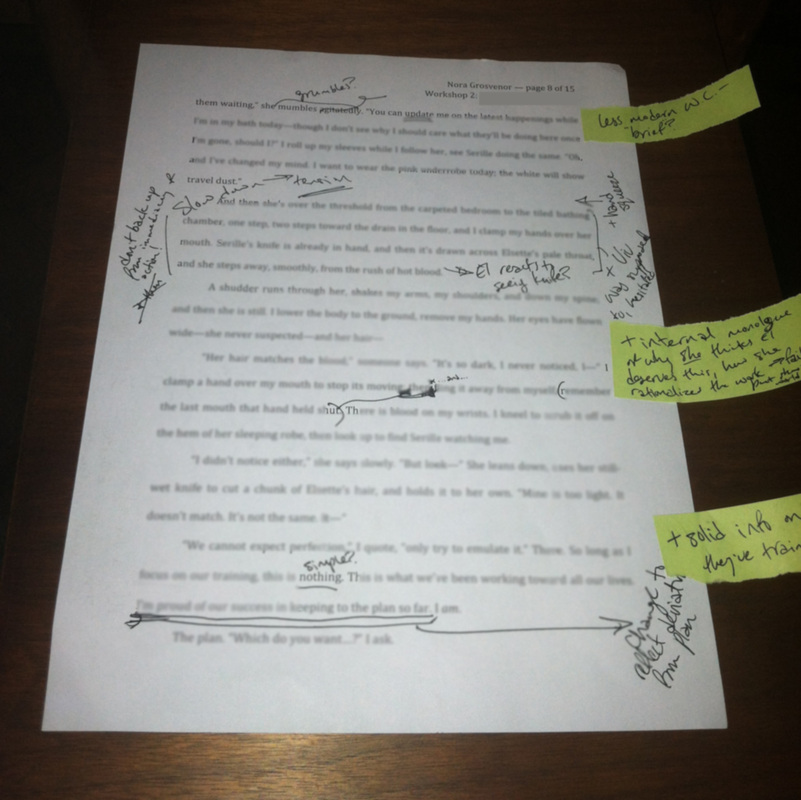What people somehow forgot to mention when we were children was that we need to make messes in order to find out who we are and why we are here.
—Anne Lamott, Bird By Bird
For one of the workshops of my recent MFA residency (USM: Stonecoast, for those interested), I submitted the first draft of the opening chapter of my current WIP. I left the residency with marked-up manuscripts and editorial letters from six of my peers and a faculty member, and a head full of their discussion.
In other words: I left the residency ready for a revision.
In other words: I left the residency ready for a revision.

I started with the notes I’d taken during the class discussion—for those not familiar with workshopping, the most common format is for each participant to have an hour or so spent on his or her manuscript (which everyone else has read, annotated, etc. in advance). While the peers go around the table discussing what worked and what didn’t, the writer in question remains silent: no explaining, no apologizing, and above all no defending. I spent the time filling a notebook with everything I heard.
So, now, a week after taking these notes, I sat down with them and spread a clean copy of my manuscript pages out on the kitchen table. (There were 15 pages—double-sided, it made only eight leafs of clutter—so the mess so far was manageable. For longer works, I’d probably recommend breaking the revisions up into smaller pieces, but I’ll get back to you after I’ve had a chance to try it out).
A few of my notes were specific—“p8: slow down!”—but most were more general: questions of setting, character, explanation. Again, I was working with a small sample, so I was quite familiar with what was on the page and where I could fit solutions in—especially with them all laid out in front of me. Not only was I able to flip to page eight, bracket a paragraph, and write a couple of notes to flesh it out in the margins, but I was able to look at the more general notes and think of specific lines where the lacking information could be added relatively smoothly. This would be much harder when working with a longer manuscript—another argument to revise in small chunks, and also to do a close reread before starting if it’s been a while since you wrote the piece (which, honestly, it should be if you’re revising; my experience here is an exception to the rule).
Solid edits, ones that I knew had to be made and those that I felt strongly were the right choice, I wrote in the margins:
Edits I would leave myself to decide on during the type-up I wrote on sticky notes, with the sticky edge along the side, ripping them horizontally to make economically-sized flags. I placed these on the edges of the manuscript, with notes like:
Once I’d finished with my own notes (there were about four pages of them, total), I moved on to the editorial letters, starting with the instructor’s and working through each of the classmates’ in turn. Again, every time I found something new, I found a place to make it work in the manuscript and wrote it either in the margin or on a sticky note.
When I’d gotten through all of those, I finally had to look at all their line-edits. I’d done well enough at keeping an organized system so far, but when you’re faced with seven copies of fifteen pages of first draft and all the new marginalia that entails… Well, it can be a tad overwhelming.
My first concern was having to flip through my hard-edit manuscript—with all these sticky flags popping out all over, shuffling through was getting to be a bit of a hassle, and I certainly couldn’t have any of them falling off. Not to mention the irritation of seeing the same copyedit on a typo, over and over, and having to check every time that you put it down the last time. A dilemma.
I solved all these problems by taking apart the manuscripts and sorting them out into their pages—all the page-ones together, all the page-twos, etc. Most of the copies had been printed double-sided, so that was a bit of a challenge, easily overcome by simply doing all the page-ones and flipping them over when I placed them on the bottom of the stack. Thus, voila! A natural segue into the next page of line-edits.
Anyway, this system worked quite well, allowing me to make thorough nit-picky edits on each page before setting it aside. Here's an example of a page once I was done with it:
So, now, a week after taking these notes, I sat down with them and spread a clean copy of my manuscript pages out on the kitchen table. (There were 15 pages—double-sided, it made only eight leafs of clutter—so the mess so far was manageable. For longer works, I’d probably recommend breaking the revisions up into smaller pieces, but I’ll get back to you after I’ve had a chance to try it out).
A few of my notes were specific—“p8: slow down!”—but most were more general: questions of setting, character, explanation. Again, I was working with a small sample, so I was quite familiar with what was on the page and where I could fit solutions in—especially with them all laid out in front of me. Not only was I able to flip to page eight, bracket a paragraph, and write a couple of notes to flesh it out in the margins, but I was able to look at the more general notes and think of specific lines where the lacking information could be added relatively smoothly. This would be much harder when working with a longer manuscript—another argument to revise in small chunks, and also to do a close reread before starting if it’s been a while since you wrote the piece (which, honestly, it should be if you’re revising; my experience here is an exception to the rule).
Solid edits, ones that I knew had to be made and those that I felt strongly were the right choice, I wrote in the margins:
- “add conversation --> humanize”
- “show physicality”
- “kitchen as reminder that people live(d) here—heart of the home”
Edits I would leave myself to decide on during the type-up I wrote on sticky notes, with the sticky edge along the side, ripping them horizontally to make economically-sized flags. I placed these on the edges of the manuscript, with notes like:
- “adrenaline wearing off—science!”
- “W.C. [word choice]: ‘upset’ --> sadness, low spirits? anxiety?”
- “+ solid info on mission?”
Once I’d finished with my own notes (there were about four pages of them, total), I moved on to the editorial letters, starting with the instructor’s and working through each of the classmates’ in turn. Again, every time I found something new, I found a place to make it work in the manuscript and wrote it either in the margin or on a sticky note.
When I’d gotten through all of those, I finally had to look at all their line-edits. I’d done well enough at keeping an organized system so far, but when you’re faced with seven copies of fifteen pages of first draft and all the new marginalia that entails… Well, it can be a tad overwhelming.
My first concern was having to flip through my hard-edit manuscript—with all these sticky flags popping out all over, shuffling through was getting to be a bit of a hassle, and I certainly couldn’t have any of them falling off. Not to mention the irritation of seeing the same copyedit on a typo, over and over, and having to check every time that you put it down the last time. A dilemma.
I solved all these problems by taking apart the manuscripts and sorting them out into their pages—all the page-ones together, all the page-twos, etc. Most of the copies had been printed double-sided, so that was a bit of a challenge, easily overcome by simply doing all the page-ones and flipping them over when I placed them on the bottom of the stack. Thus, voila! A natural segue into the next page of line-edits.
Anyway, this system worked quite well, allowing me to make thorough nit-picky edits on each page before setting it aside. Here's an example of a page once I was done with it:
It took a while, and was rather tedious work—I’d say five or six hours total—but by the end I had compiled a hard-copy edit that I was rather pleased with. Granted, I was surrounded by stacks of pages, torn-up sticky notes, ripped-out paperclips, and one highly-scribbled-on manuscript—not the neatest of environs—but I knew exactly what I had to do to polish this chapter up into a firm stepping-stone from which to progress into my story.
Of course, the work was only half-done, if that. I still had to take this sloppily-paperclipped blueprint up to my desk, reopen the digital file (I use Scrivener, but any word processor will do) and do a full revision, paragraph by paragraph. This took me about four days’ work.
So, there you have it! Your workshop feedback may look dense and overwhelming, but with (approximately) one week of labor, you too can have a revised chapter—without the panic attack. Utterly manageable. Now go dust off your notes and start integrating them! (And if you have any tips for revising, I'd love to hear them in the comments.)
Of course, the work was only half-done, if that. I still had to take this sloppily-paperclipped blueprint up to my desk, reopen the digital file (I use Scrivener, but any word processor will do) and do a full revision, paragraph by paragraph. This took me about four days’ work.
So, there you have it! Your workshop feedback may look dense and overwhelming, but with (approximately) one week of labor, you too can have a revised chapter—without the panic attack. Utterly manageable. Now go dust off your notes and start integrating them! (And if you have any tips for revising, I'd love to hear them in the comments.)

 RSS Feed
RSS Feed